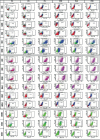Stem cells of fallopian tube mucosa lost their stemness characteristics under prolonged conditions
- PMID: 35238504
- PMCID: PMC9355437
- DOI: 10.5935/1518-0557.20210097
Stem cells of fallopian tube mucosa lost their stemness characteristics under prolonged conditions
Abstract
Objective: Stem cells have been identified from various adult sources, including bone marrow, adipose tissue, and placenta, to name a few. Recently, the fallopian tube has also been identified as a novel source of therapeutics. However, the ability of stem cells from the fallopian tube mucosa to retain prolonged efficacy of proliferation and differentiation is yet to be explored. This forms the basis of the present study.
Methods: Stem cells isolated from the fallopian tube mucosa were tested for their marker characterization (markers of mesenchymal, pericyte, epithelial, and cell adhesion molecules) at various passages (P1, P3, P5, P10, P15). Proliferation, differentiation (osteoblast and adipocytes), and karyotyping were also carried out at both early (P3) and late (P15) passages.
Results: Fallopian tube mucosa possesses mesenchymal stem cells, but they do not retain the ability to proliferate and differentiate beyond P15.
Conclusions: Although fallopian tube mucosal MSCs (FT-MMSCs) possess stem cell attributes, they cannot outweigh or be used in parallel to existing stem cell sources due to their inability to retain stemness characteristics beyond P15. Since FT-MMSC studies are in their infancy, further in-depth research is warranted to test whether FT-MMSCs have a use in bench to bedside applications. FT-MMSCs might be linked to tubal inflammation and fallopian tube hyperplasia, which contributes to a possible role in diagnostics and in providing insights for the betterment of womankind.
Keywords: fallopian tube mucosa; long-term culture; mesenchymal stem cells; multipotent differentiation; proliferation.
Figures








Similar articles
-
The utility of human fallopian tube mucosa as a novel source of multipotent stem cells for the treatment of autologous reproductive tract injury.Stem Cell Res Ther. 2015 May 21;6(1):98. doi: 10.1186/s13287-015-0094-1. Stem Cell Res Ther. 2015. PMID: 25994820 Free PMC article.
-
Regeneration of the Fallopian Tube Mucosa Using Bone Marrow Mesenchymal Stem Cell Transplantation After Induced Chemical Injury in a Rat Model.Reprod Sci. 2018 May;25(5):773-781. doi: 10.1177/1933719117725824. Epub 2017 Aug 22. Reprod Sci. 2018. PMID: 28826366
-
Nongynecologic metastases to fallopian tube mucosa: a potential mimic of tubal high-grade serous carcinoma and benign tubal mucinous metaplasia or nonmucinous hyperplasia.Am J Surg Pathol. 2015 Jan;39(1):35-51. doi: 10.1097/PAS.0000000000000293. Am J Surg Pathol. 2015. PMID: 25025442
-
Mesenchymal stem cells.Cell Transplant. 2011;20(1):5-14. doi: 10.3727/096368910X. Cell Transplant. 2011. PMID: 21396235 Review.
-
Pathogenesis of Neisseria gonorrhoeae and the Host Defense in Ascending Infections of Human Fallopian Tube.Front Immunol. 2018 Nov 21;9:2710. doi: 10.3389/fimmu.2018.02710. eCollection 2018. Front Immunol. 2018. PMID: 30524442 Free PMC article. Review.
References
-
- Dhanasekaran M, Indumathi S, Rashmi M, Rajkumar JS, Sudarsanam D. Unravelling the retention of proliferation and differentiation potency in extensive culture of human subcutaneous fat-derived mesenchymal stem cells in different media. Cell Prolif. 2012;45:516–526. doi: 10.1111/j.1365-2184.2012.00843.x. - DOI - PMC - PubMed
-
- Dhanasekaran M, Indumathi S, Lissa RP, Harikrishnan R, Rajkumar JS, Sudarsanam D. A comprehensive study on optimization of proliferation and differentiation potency of bone marrow derived mesenchymal stem cells under prolonged culture condition. Cytotechnology. 2013;65:187–197. doi: 10.1007/s10616-012-9471-0. - DOI - PMC - PubMed
MeSH terms
LinkOut - more resources
Full Text Sources
Miscellaneous

